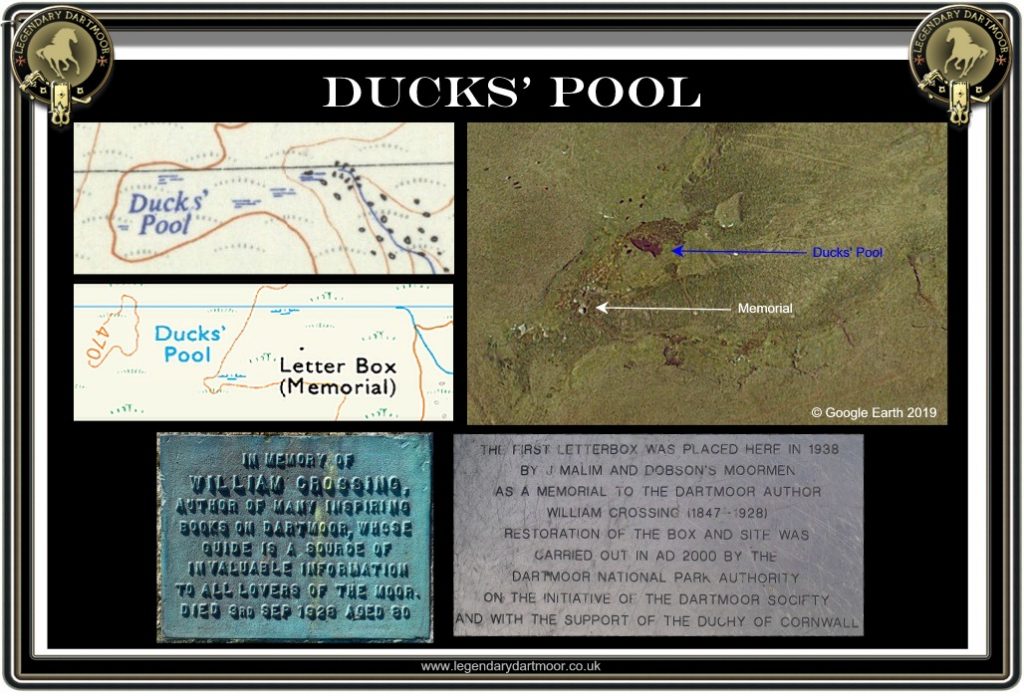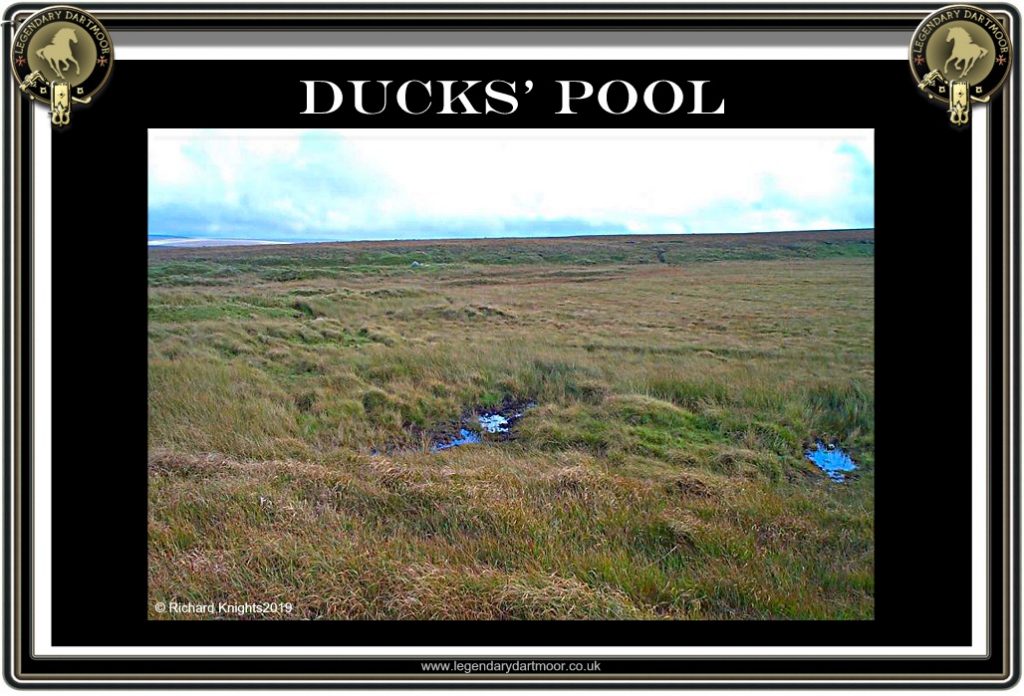
A labourer from the little village of Harford had heard some old ladies saying that anyone who went to Duck’s Pool and remained there until after midnight without getting piskie led would be rewarded by the faeries. So being stony broke the man decided that he would risk the wrath of the little people and go out to Duck’s Pool on the next full moon, that way he would have some light to help him across the dark moors. The only problem was that he had no idea where Duck’s Pool was, he just knew it was somewhere up on the moor. The next day whilst he and some of the other workers were out in the fields he decided to ask one of the old moor men. The old boy looked at him quizzically, “what do ee wan’ tu go to thick place fur?”. The labourer the proceeded to tell him of his mission. The old man just laughed and said, “passel of ole crams (rubbish), dun’ ee believe such ole nonsense, ee wan’t get naught from the faeries as there be no sich thing, ee must be mazed!” But the lad persisted and was finally told to walk up the river Erme until he reached the old tinners workings at Erme Pits and then head north. It was going to be a 14 mile round trip but the thought of the faerie reward stiffened his resolve.
A few nights later was a full moon so the labourer rugged himself up and strode out onto the moor. Luckily it was a cloudless night and the moon lit his way better than a lantern. Up the river he went, past the stunted oaks of Piles Copse, across by the old stone row known as the dancers, on along Erme Plains, up past the Erme Cattle pound and eventually tired and breathless he reached the tinner’s workings of Erme Pits. From here he crossed the river and headed north, but could he find the pool? He zig-zagged across the wet, boggy ground in desperate search of a pool – nothing. Then he remembered the old man saying something about “when ee siz a ‘uge boulder then ee u’ll knaw ee be there,” and sure enough he could just make out a huge black shadowy lump and so slopped through the boggy mire towards it. When the lad reached the rock he saw a small pool of water and so realised that this must be Duck’s Pool. He then searched for a nice comfortable tussock to sit on and having found one started his midnight vigil. The moor was silent and still, the moonlight gave it an eerie pall and as the minutes ticked away his mind started to play tricks, “where was that noise, is something dancing on that rock, what if the piskie did come?” The labourer decided that should he get piskie led he would turn his coat inside out and then simply find the river Erme and follow it back to Harford – if it were that easy! Slowly the hours passed by, every now and again he would strike a match so he could see his watch, nine, ten and then eleven o’clock, still nothing. The youngster wished he had brought a crust or two of bread because now he was getting cold and hungry. The lad also realised that by now all the others farm workers would have heard of his quest and what would he tell them in the morning? He knew they would rib him for ages about his tom foolery. The labourer was actually beginning to wish the piskies would come and then the faeries could give him his reward and he could go back to his warm bed. The lad once again took out his matches and struck the last one, it was two minutes past midnight, his heart sank, all this for nothing but a good ribbing. He slowly clambered out of the tussock and stood up surveying the pool in one last desperate attempt to find the faeries.
Suddenly a load squelching sound could be heard coming from behind a huge peat hag, it was getting louder and coming towards him. This did not sound like any faerie it was making far too much noise. A huge figure loomed over the hag, it was enveloped in a steaming mist. The labourer knew not what to do, he had been warned about the piskies but nobody had mentioned a night stalking demon. The lad decided to put on a brave face, “you’m out a bit latish, ain’t ee,” he stammered. The figure walked up to him, “yes my friend later than I should wish, I left Princetown this afternoon and since then I have been wandering these god forsaken bogs, I would willingly give a gold sovereign to anyone who could lead me off this blessed moor.” By now the lad could see that this was no Demon from hell, it was simply some gent who had got himself lost, “where do ee wan’ a go,” he asked. “I am staying at Ivybridge but if I could get to Harford Bridge I can find my way from there,” the gent replied. With that the labourer held out his hand and gratefully received the shiny sovereign, he had never held so much wealth in his entire life. The coin was safely placed in his purse and with that he smiled at the gent and said “please to follow I, zir.”
The following morning all his fellow workers were assembled to hear of the lads quest. The old man sensing some sport could contain himself no longer, “well, an’ ‘ow much coin did the nice faeries give ee,” he gloated. The shepherd started to snigger, “bet t’was a passel, a passel of ol’ crams,” he jeered. “All ee got waz some achey feet,” the ploughman exclaimed. The young labourer smiled sweetly and slowly replied, “well if ee mus’ knaw, I went to the pool, staid ’til midnight an’ then all at wance I found this in me ‘and,” he opened his purse and showed them the shiny gold sovereign. Mouths were agape, feet were shuffling and the silence was deafening. The ploughman snorted and stomped off to the stables, the shepherd just scowled and whistled his dog and the old man had secretly decided to go up to Duck’s Pool that very night.
Duck’s Pool is very much like Cranmere Pool, as today there is virtually no pool but a boggy depression, however there are more rocks and boulders than Cranmere. The main attractions are one huge boulder and a small ‘letterbox‘ sitting below it with its visitors book. The letterbox is the second of just two that are still marked on the Ordnance Survey maps (the other is Cranmere pool). The idea of first establishing a letterbox was first muted around 1934 by Frederick Symes aka ‘Mooroaman’. Jeffrey W. Malin then extolled the virtues of Duck’s Pool in his 1935 book – ‘The Romance of Dartmoor‘ he writes; “Duck’s Pool, however, is hardly known to more than a few ardent walkers on the moor, and should be introduced as the southern centre of attraction, by means of a post-box and stamp placed in a cubby hole, in the southern embankment. It is similarly placed to Cranmere, being near the head of a river, in an extensive hollow on a high plateau in bogland, difficult to access, and equally lonely, the only difference in favour of Duck’s Pool which has a considerable amount of water in it, justifying the name of a pool. I put a walking=stick into the water at the margin and it showed a depth of three feet. There are reeds, sedges, mosses and marsh plants growing in this miry pool and these make a picture of browns and greens with all the shades of their beautiful and varied colours.” p.58. Over the next few years Mr. Malim must have brooded on the idea of enticing walkers to visit the pool and how to achieve such a thing. And in the December of 1938 the Western Morning News announced that; “a postbox similar to the one at Cranmere has recently been placed at Duck’s Pool through the energies of “Moorover” (Dr. J. W. Malim of St. Marychurch), and that a bronze tablet is shortly to be fixed there in memory of William Crossing, the Dartmoor Explorer.” The first letterbox and stamp was initially kept in a teak box which was later replaced with a zinc container.
On the 18th of October 1938 the editor of the Western Morning News received a postcard with an impression of the Ducks’ Pool letterbox stamp along with these words; “Hearty greetings from Moorover! If you have not been here, you will enjoy the walk by way of Eylesbarrow and Plym Ford to Plym Head. The post-box is to be found on the southern bank, at the foot of the pool. where the water lies. the cast bronze memorial to William Crossing is not yet fixed on the boulder above the cubby-hole.” Also involved with the Duck’s Pool letterbox were the Dobson’s Moormen. In the December of 1940 the following appeared in the Western Morning News; “Dobson’s Moormen also played a considerable part in collaboration with another group of Dartmoor enthusiasts, the originators of the scheme, in the establishment of a tablet, letter-box, and visitor’s book at Duck’s Pool, near the headwaters of the river Plym, in memory of the well-know Dartmoor author William Crossing.” – December 23rd.
In the 1941 ‘Globe and Laurel’ magazine of the Royal Marines Malim wrote a short piece describing how whilst of duty he walked to Duck’s Pool. During his visit there he saw some German parachutists land nearby. He described how he guided them away to ‘safety’ and led them straight into the notorious Aune Head Mires and watched them disappear one by one into the bog. He ended his story by relating how he then suddenly woke up and found himself sitting in uniform at a railway station.
In 1963 a new post box container was placed at the pool and this one had an engraved tablet affixed to its lid as a memorial to Mr R. C. Carter, a founder of the Dobson’s Moormen. Naturally having such an accolade it’s no wonder that Ducks’ Pool has been a favourite spot for siting many other letterbox sites, a few of which can be seen above. Very much in the same tradition of Cranmere Pool should anyone leave a stamped addressed letter or card in the official box site there is a good chance that the next visitor will post it back.
As can be seen above the bronze plaque was indeed placed above the boulder beneath which lies the postbox. In 1997 six dozen or so walkers made the trek out to Duck’s Pool on the afternoon of 14th November to celebrate the 150th birthday of Dartmoor’s most famous author.
 Legendary Dartmoor The many aspects past and present of Dartmoor
Legendary Dartmoor The many aspects past and present of Dartmoor




Hi Tim
A great site, which I refer to quite a lot.
In your page on Duck’s Pool you refer to a 1941 article in Globe & Laurel magazine as being by Dr J W Malim (“Moorover). This is incorrect. The article is by Mooranger, A P Thompson of Sunnyside, Axminster – I have a copy of the article. The two were very good friends, and he refers to Malim in the article. I have a particular interest in Malim, as I am an amateur local historian living close to his home in St Marychurch, and I have made a detailed study of his life and work.